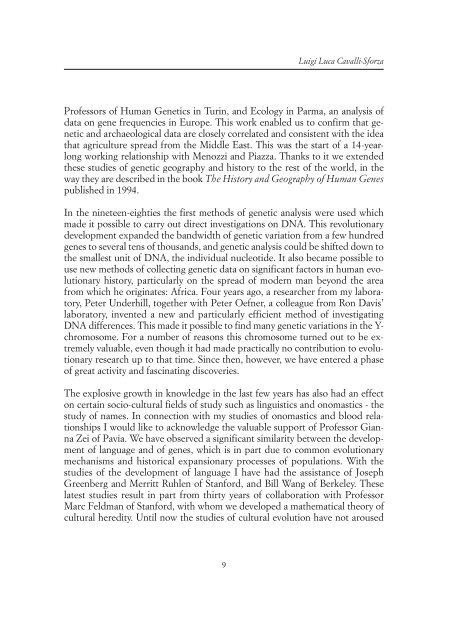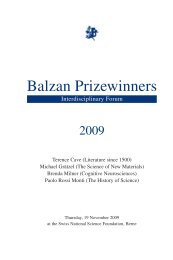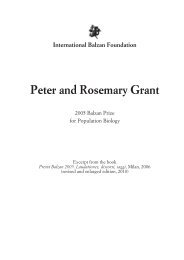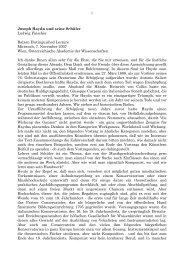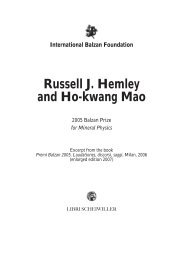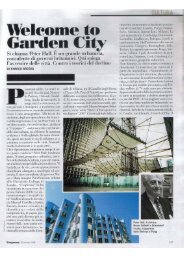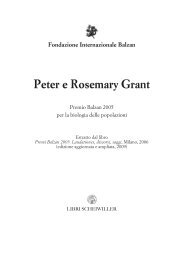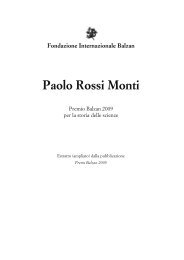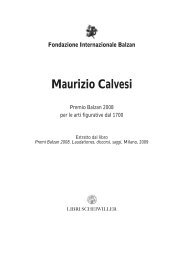International Balzan Foundation Luigi Luca Cavalli
International Balzan Foundation Luigi Luca Cavalli
International Balzan Foundation Luigi Luca Cavalli
Create successful ePaper yourself
Turn your PDF publications into a flip-book with our unique Google optimized e-Paper software.
<strong>Luigi</strong> <strong>Luca</strong> <strong>Cavalli</strong>-Sforza<br />
Professors of Human Genetics in Turin, and Ecology in Parma, an analysis of<br />
data on gene frequencies in Europe. This work enabled us to confirm that genetic<br />
and archaeological data are closely correlated and consistent with the idea<br />
that agriculture spread from the Middle East. This was the start of a 14-yearlong<br />
working relationship with Menozzi and Piazza. Thanks to it we extended<br />
these studies of genetic geography and history to the rest of the world, in the<br />
way they are described in the book The History and Geography of Human Genes<br />
published in 1994.<br />
In the nineteen-eighties the first methods of genetic analysis were used which<br />
made it possible to carry out direct investigations on DNA. This revolutionary<br />
development expanded the bandwidth of genetic variation from a few hundred<br />
genes to several tens of thousands, and genetic analysis could be shifted down to<br />
the smallest unit of DNA, the individual nucleotide. It also became possible to<br />
use new methods of collecting genetic data on significant factors in human evolutionary<br />
history, particularly on the spread of modern man beyond the area<br />
from which he originates: Africa. Four years ago, a researcher from my laboratory,<br />
Peter Underhill, together with Peter Oefner, a colleague from Ron Davis’<br />
laboratory, invented a new and particularly efficient method of investigating<br />
DNA differences. This made it possible to find many genetic variations in the Ychromosome.<br />
For a number of reasons this chromosome turned out to be extremely<br />
valuable, even though it had made practically no contribution to evolutionary<br />
research up to that time. Since then, however, we have entered a phase<br />
of great activity and fascinating discoveries.<br />
The explosive growth in knowledge in the last few years has also had an effect<br />
on certain socio-cultural fields of study such as linguistics and onomastics - the<br />
study of names. In connection with my studies of onomastics and blood relationships<br />
I would like to acknowledge the valuable support of Professor Gianna<br />
Zei of Pavia. We have observed a significant similarity between the development<br />
of language and of genes, which is in part due to common evolutionary<br />
mechanisms and historical expansionary processes of populations. With the<br />
studies of the development of language I have had the assistance of Joseph<br />
Greenberg and Merritt Ruhlen of Stanford, and Bill Wang of Berkeley. These<br />
latest studies result in part from thirty years of collaboration with Professor<br />
Marc Feldman of Stanford, with whom we developed a mathematical theory of<br />
cultural heredity. Until now the studies of cultural evolution have not aroused<br />
9


